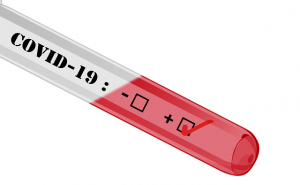In the UK, biochemist Iain R. Hargreaves and medical doctor David Mantle have written that the initial immune system response to the Covid-19 virus and the subsequent resolution of the resulting inflammation may well be dependent upon nutritional status, including micronutrient status. Accordingly, they have investigated the relationship between the status of two micronutrients, Coenzyme Q10 and selenium, and the effect on oxidative stress and inflammation [Hargreaves & Mantle 2021].

In a 2021 review article, Hargreaves and Mantle write that adequate intakes of both Coenzyme Q10 and selenium are necessary for optimal immune system defense against Covid-19 infections.
They conclude that optimal status of both Coenzyme Q10 and selenium may be one aspect of an effective program to prevent and treat Covid-19 infections [Hargreaves & Mantle 2021]. The important thing in dealing with Covid-19 infections is to achieve and maintain a balance in the immune response against the virus without causing a cytokine storm as the cytokine storm is the cause of lung injury and respiratory distress in severe cases.
Coenzyme Q10 and the Immune System
Hargreaves and Mantle point out that Coenzyme Q10 is needed in sufficient quantities for good immune system function:
- Coenzyme Q10 has an essential role in cellular energy generation; the cells of the immune system need energy to function optimally.
- The reduced state of Coenzyme Q10, known as ubiquinol, is a lipid-soluble antioxidant that protects the cells from oxidative damage induced by harmful free radicals. Hargreaves and Mantle stress this point because phagocytic cells destroy invading pathogens through the production of free radicals. CoQ10’s antioxidant role may protect the phagocytic cells from self-destruction caused by their secretion of too many free radicals.
- There is evidence that Coenzyme Q10 moderates the action of genes that are involved in inflammation and that Coenzyme Q10 helps to control the release of pro-inflammatory cytokines.
- Coenzyme Q10 plays an essential role in maintaining lysosomal acidification. This could be significant because it has now been shown that the Covid-19 virus de-acidifies the lysosomes by an unknown mechanism. The de-acidification decreases lysosomal hydrolytic enzyme activity and impairs the antigen presentation role of the lysosomes.
In sum, Coenzyme Q10 may be what is needed to enhance the immune response against the virus [Hargreaves & Mantle 2021].
Decreasing CoQ10 Bio-Synthesis with Increasing Age
The thing to remember is that, in our adult years, our cells synthesize less and less Coenzyme Q10. We cannot make up the loss by eating more or by eating wisely. Daily supplementation is a necessity. We need the extra Coenzyme Q10 for cellular energy generation and cellular antioxidant protection [Judy 2018].
Moreover, it is known that certain prescription drugs, statins and biophosponates in particular, reduce the ability of the cells to bio-synthesize Coenzyme Q10 [Okuyama 2015].
Synergistic Interaction at the Cellular Level Between CoQ10 And Selenium
Selenium is a trace element that we must get from diet and supplements. Supplements are particularly important in selenium-poor regions of the world [Haug 2007].
Selenium is essential for the optimal functioning of both the innate and adaptive immune systems [Hargreaves & Mantle 2021].
Selenium is a component of the antioxidant seleno-enzymes known as the glutathione peroxidases and a component of the seleno-enzymes known as the thioredoxin reductases [Hargreaves & Mantle 2021].
Selenium is needed for the reduction of CoQ10 molecules to the ubiquinol state. Hargreaves and Mantle suggest that supplementation with Coenzyme Q10 alone is not likely to have an optimal effect against Covid-19 if the level of selenium is sub-optimal.
Oxidative Stress and Inflammation
Oxidative Stress
We are more vulnerable to the deleterious effects of oxidative stress if we have sub-optimal levels of Coenzyme Q10 or antioxidative seleno-enzymes or both.
Oxidative damage to cells and tissues occurs when there is a predominance of harmful free radicals over protective antioxidants. The irony is that the highly reactive free radicals are produced in all cells as a by-product of normal cell metabolism [Hargreaves & Mantle 2021].
Sub-optimal levels of selenium are associated not only with increased oxidative stress but also with the altering of the genome of viruses in such a way that an otherwise benign or mildly pathogenic virus can become highly virulent [Beck 2003].
Inflammation
Typically, inflammation is a part of the body’s response to infection, and, normally, the inflammatory process is shut down after the tissue repair via an inflammation negative feedback loop [Hargreaves & Mantle 2021].
But, in some Covid-19 patients, the inflammation is uncontrolled and is characterized by the cytokine storms that we hear so much about. These cytokine storms cause damage in the lungs, heart, liver, and kidneys. The Covid-19 patients who suffer organ damage are known to have high blood levels of the pro-inflammatory cytokines IL-1, IL-6, and TNF [Hargreaves & Mantle 2021].
A 2017 meta-analysis of data from randomized controlled trials revealed that CoQ10 supplementation is associated with significant lowering effects on inflammatory mediators including C-reactive protein, interleukin-6, and tumor necrosis factor-α [Fan 2017].
Summary: Supplementation with Coenzyme Q10 and Selenium
What do we know?
CoQ10 Supplementation
- Aging and certain prescription drugs, statins chief among them, are associated with reduced CoQ10 status.
- Depleted CoQ10 levels have been associated with an increased susceptibility to infection.
- Oxidative stress and uncontrolled inflammation are among the consequences of Covid-19 infections.
- CoQ10 supplementation is associated with improved antioxidant capacity and with enhanced modulation of inflammation.
Selenium Supplementation
- Selenium supplementation is associated with modulated inflammatory response and with restored antioxidant capacity.
- A definite link between regional selenium status and recovery outcomes has been reported in Covid-19 cases in China [Zhang 2020].
Summary: Combined CoQ10 and Selenium Supplementation
In the randomized placebo-controlled KiSel-10 Study, researchers gave healthy elderly Swedish citizens (average age: 78 years), who were low in selenium, a combined treatment of 2 x 100 mg of Coenzyme Q10 and 200 mcg of selenium from selenium-enriched yeast or matching placebos daily for four years. The study participants who were given the combined CoQ10 and selenium supplementation had significantly reduced cardiovascular mortality and significant reductions in the blood levels of two bio-markers for oxidative stress and five bio-markers of inflammatory response [Alehagen 2013; Alehagen 2015a; Alehagen 2015b; Alehagen 2019].
Hargreaves and Mantle conclude that the positive effects of combined CoQ10 and selenium supplementation on oxidative stress and inflammation show promise in the treatment of patients with COVID-19 disease. They recommend taking a CoQ10 supplement that is manufactured to pharmaceutical standards and that has documented bioavailability in human subjects [Lopez-Lluch 2019]. Similarly, with respect to selenium supplements, they recommend taking a supplement that is manufactured to pharmaceutical standards.
Sources:
Alehagen U, Johansson P, Björnstedt M, Rosén A. Cardiovascular mortality and N-terminal-proBNP reduced after combined selenium and coenzyme Q10 supplementation: A 5-year prospective randomized double-blind placebo-controlled trial. Int J Cardiol. 2013;167:1860-1866.
Alehagen U, Aaseth J, Johansson P. Less increase of copeptin and MR-proADM due to intervention with selenium and coenzyme Q10 combined: Results from a 4-year prospective randomized double-blind placebo-controlled trial among elderly Swedish citizens. Biofactors. 2015a;41:443-52.
Alehagen U, Lindahl TL, Aaseth J, Svensson E. Levels of sP-selectin and hs-CRP decrease with dietary intervention with selenium and coenzyme Q10 combined: a secondary analysis of a randomized clinical trial. PLoS One. 2015b;10:e0137680.
Alehagen U, Alexander J, Aaseth J, Larsson A. Decrease in inflammatory biomarker concentration by intervention with selenium and coenzyme Q10: a subanalysis of osteopontin, osteoprotergerin, TNFr1, TNFr2 and TWEAK. J Inflamm (Lond). 2019;16:5.
Beck MA, Levander OA, Handy J. Selenium deficiency and viral infection. J Nutr. 2003 May;133(5 Suppl 1):1463S-7S.
Fan L, Feng Y, Chen GC, Qin LQ, Fu CL, Chen LH. Effects of coenzyme Q10 supplementation on inflammatory markers: A systematic review and meta-analysis of randomized controlled trials. Pharmacol Res. 2017 May;119:128-136.
Hargreaves IR / Mantle D. COVID-19, Coenzyme Q10, and Selenium. Chapter 13 in: Guest PC, ed. Identification of Biomarkers, New Treatments, and Vaccines for COVID-19. Advances in Experimental Medicine and Biology. 2021;1327:163-168.
Haug A, Graham RD, Christophersen OA, Lyons GH. How to use the world’s scarce selenium resources efficiently to increase the selenium concentration in food. Microbial Ecology in Health and Disease. 2007 Dec;19(4):209-228.
Judy WV. Coenzyme Q10: An Insider’s Guide. 2018. ISBN: 978-87-7776-186-7. Available from amazon.com.
López-Lluch G, Del Pozo-Cruz J, Sánchez-Cuesta A, Cortés-Rodríguez AB, Navas P. Bioavailability of coenzyme Q10 supplements depends on carrier lipids and solubilization. Nutrition. 2019 Jan;57:133-140.
Okuyama H, Langsjoen PH, Hamazaki T, Ogushi Y, Hama R, Kobayashi T, Uchino H. Statins stimulate atherosclerosis and heart failure: pharmacological mechanisms. Expert Rev Clin Pharmacol. 2015 Mar;8(2):189-99.
Zhang J, Taylor EW, Bennett K, Saad R, Rayman MP. Association between regional selenium status and reported outcome of COVID-19 cases in China. Am J Clin Nutr. 2020 Jun 1;111(6):1297-1299.
The information presented in this review article is not intended as medical advice and should not be used as such.
30 August 2021



Leave A Comment